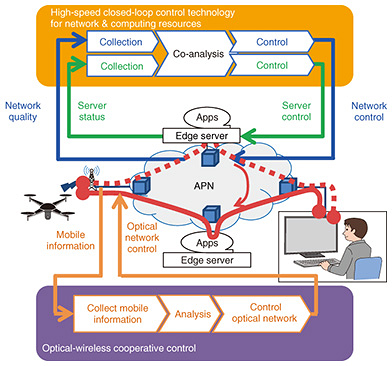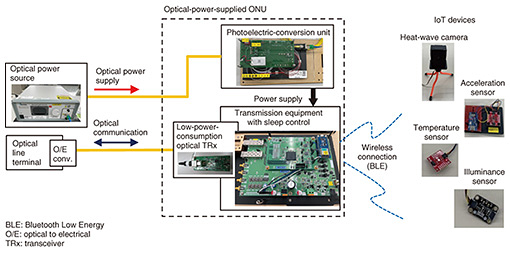 |
|||||||||||||
|
|
|||||||||||||
|
Feature Articles: Keynote Speeches and Workshop Lectures at Tsukuba Forum 2023 Vol. 21, No. 9, pp. 48–51, Sept. 2023. https://doi.org/10.53829/ntr202309fa7 Low-latency and Energy Efficient Technologies for New Optical Access NetworksAbstractNTT laboratories are engaged in the research and development of technologies to overcome increasing data volume, power consumption, and network delay. This article introduces the technologies that contribute to low latency and power saving of optical access networks being researched and developed by the Optical Access System Project at NTT Access Network Service Systems Laboratories. Keywords: optical access systems, low-latency FDN, APN 1. High expectations for low-latency optical access networksThe concept of the Innovative Optical and Wireless Network (IOWN) envisions a network and information processing infrastructure to provide high-speed, high-capacity communications and enormous computational resources using innovative technologies that are based on photonics and optics, and the IOWN Global Forum (IOWN GF), which brings together various companies for discussions, is taking the lead in implementing IOWN. IOWN GF aims to naturally provide capabilities beyond human cognition that enable extremely high-definition video, perceptual displays, and large-volume transmission. It also discusses use cases and technologies for computing resources and devices. IOWN GF exemplifies use cases that enhance immersion and extend human cognition, such as cyber-physical systems that collect data from a large number of cameras and sensors in real time to predict the future and perform autonomous control as well as remote-control and extended-reality navigation. Low-latency and robust networks are key for these use cases. For example, low latency and stability of the communication environment are required in the guidelines for remote surgery formulated by the Japanese Surgical Society [1]. To cope with the decrease in the working-age population, improving productivity and reducing dangerous work are urgent issues, so a low-latency and stable network to enable precise remote control is necessary. 2. Network technology for low latencyThe All-Photonics Network (APN), which is a component of IOWN, is expected to provide stable low-latency communication that takes advantage of the characteristics of optical fiber. However, to achieve precise remote operation, it is necessary not only to control the delay in transmission but also reduce the time required for the input, processing, and output of information, which is part of the delay of the entire communication, and to have a mechanism that enables smooth remote operation to continue even if a failure occurs at various points. We at the Optical Access System Project in NTT Access Network Service Systems Laboratories are developing a network technology called low-latency functional dedicated network (FDN) to enable quick response to changes in network and services and rapidly allocate and swap computing resources for edge processing (Fig. 1). This makes it possible to provide a stable low-latency and low-jitter network for the entire remote-control system, including optical and edge processing sections. For the practical and widespread use of remote-control services, we are advancing “high-speed closed-loop control technology for network & computing resources,” which takes advantage of cloud technology, especially edge computing, to enhance the reliability of image processing and artificial-intelligence processing (Fig. 2). This technology monitors connection quality by collecting information on the status of both the network and edge server, ensuring stability by switching the route and server simultaneously when quality becomes degraded. At the Tsukuba Forum 2023, we demonstrated an application that uses this high-speed closed-loop control technology for network & computing resources to operate a remote robot-arm through a screen and maintain high stability to continue operations even if remote-control delay is caused by the increasing background traffic on the edge server.
We are also researching and developing another low-latency technology that can be used to stably control multiple robots in a factory. It leverages time-aware shaper (TAS) technology [2] for mission-critical data transfer between multi-access edge computing (MEC) and a large number of terminals located near the user. TAS technology was originally developed as a traffic-control technology for mediating and multiplexing communications with very strict delay requirements, but it is applicable to a mechanism that executes cooperative control among multiple switches, i.e., the entire network. We demonstrated how this technology can ensure low latency for each control message between any terminal in a factory and MEC, enabling the simultaneous control of multiple delicate robotic arms. 3. Optical-power-supplied optical network unitA promising use case for Internet of Things (IoT) is data collection in rural areas and unmanned environments, such as for observations in mountainous areas and the sea, and for monitoring facilities such as dams. In such areas, however, it is sometimes difficult to supply power through power lines. IoT devices using solar cells, energy-harvesting technology, and low power wide areas (LPWAs) have been proposed, but there are still many issues with stable power supply and the limitation of radio propagation distance. For example, in these severe climate environments, solar cells and energy-harvesting technologies are not stable power sources due to topography, weather, vegetation, and other conditions, and LPWAs are also limited in their propagation distance. Therefore, NTT Access Network Service Systems Laboratories is researching and developing an optical-power-supplied optical network unit (ONU) that enables IoT communication by using optical energy supplied through optical fibers [3]. We developed a prototype optical transceiver that operates with low power consumption and demonstrated it by installing a mechanism in which the ONU is put to sleep when communication is not needed to thoroughly suppress average power consumption while being charged by optical power received by the photoelectric conversion unit (Fig. 3). We demonstrated this optical-power-supplied ONU at the Tsukuba Forum 2023.
4. Research and development trends of Photonic GatewayNTT Access Network Service Systems Laboratories conducted research and development on the Photonic Gateway (Ph-GW), which provides the functions required for user accommodation in the APN through full-mesh optical paths by end-to-end connecting terminals and using as little electrical processing as possible. The Ph-GW consists of (1) remote wavelength control, (2) multiplexing/demultiplexing, (3) pass/block, (4) turn back, and (5) add/drop using optical technology and provides end-to-end main signal opening and stopping without the user being aware of the communication protocol. NTT Access Network Service Systems Laboratories has demonstrated that these five functions are feasible [4, 5]. These functional block groups constituting the Ph-GW were proposed in IOWN GF and consented to be described as APN-G [6]. Functions (2), (3), and (5) are possible by extending the functions of a reconfigurable optical add/drop multiplexer (ROADM), which is an optical transmission device, and the Open ROADM Multi-Source Agreement has started to discuss them. Other goals, such as remote monitoring control, miniaturization of APN terminals, and cost reduction, are being investigated; thus, we will continue researching and developing the Ph-GW. We believe that users should experience the APN with available technology so that they will become aware of its advantages. Therefore, we would like to expand functions through continued research and development. References
|
|||||||||||||




